Novel Quantitative Evaluation of Biotreatment Suitability of Wastewater
Abstract
:1. Introduction
2. Methodology
2.1. Classification of Wastewater Bio-Treatment Characteristics
2.2. Bio-Treatment Evaluation Process of Wastewater
2.3. Stage Division of Biological Treatment Process
2.4. Bio-Treatment Feature Evaluation Experiment
3. Application of Quantitative Evaluation for Bio-Treatment in a Wastewater Treatment Plant
3.1. Water Quality Analysis of Textile Wastewater
3.2. Effect of Existing Treatment Processes on the Wastewater Biodegradability
3.3. Effect of Extra Nutrition on Bio-Treatment of Textile Wastewater
4. Conclusions
Author Contributions
Funding
Acknowledgments
Conflicts of Interest
Appendix A
| Pollutant Indicators | Measured Methods | Standard/Instrument |
|---|---|---|
| COD | Dichromate oxidation | ISO6060 |
| BOD | Differential pressure detection | Automatic BOD Tester |
| TOC | Combustion | TOC Analyzer |
| SS | Weigh after filtration | 0.45-micron filter, balance |
| TN | Potassium Persulfate Oxidation, Spectrophotometry | Spectrophotometer |
| TP | Ammonium molybdate, spectrophotometry |
Appendix B
| Ingredient | Concentration (mg/L) | Ingredient | Concentration (mg/L) |
|---|---|---|---|
| Glucose | 500 | CaCl2 | 60 |
| Starch | 400 | (NH4)2SO4 | 250 |
| Petone | 200 | K2HPO4 | 60 |
| Urea | 60 | MnSO4 | 8 |
| NaHCO3 | 300 | FeSO4 | 1.2 |
| NaCl | 400 |
| Reaction Condition | Parameter |
|---|---|
| Stirring rate | 10, 40, 80, 100 rad/min |
| Temperature | 10 °C, 15 °C, 20 °C, 25 °C, 30 °C |
| pH | 5, 7, 9 |
Appendix C. System Optimization Results of Evaluation for Wastewater Bio-Treatment
Appendix C.1. Effect of Temperature on the Bio-Treatment Process
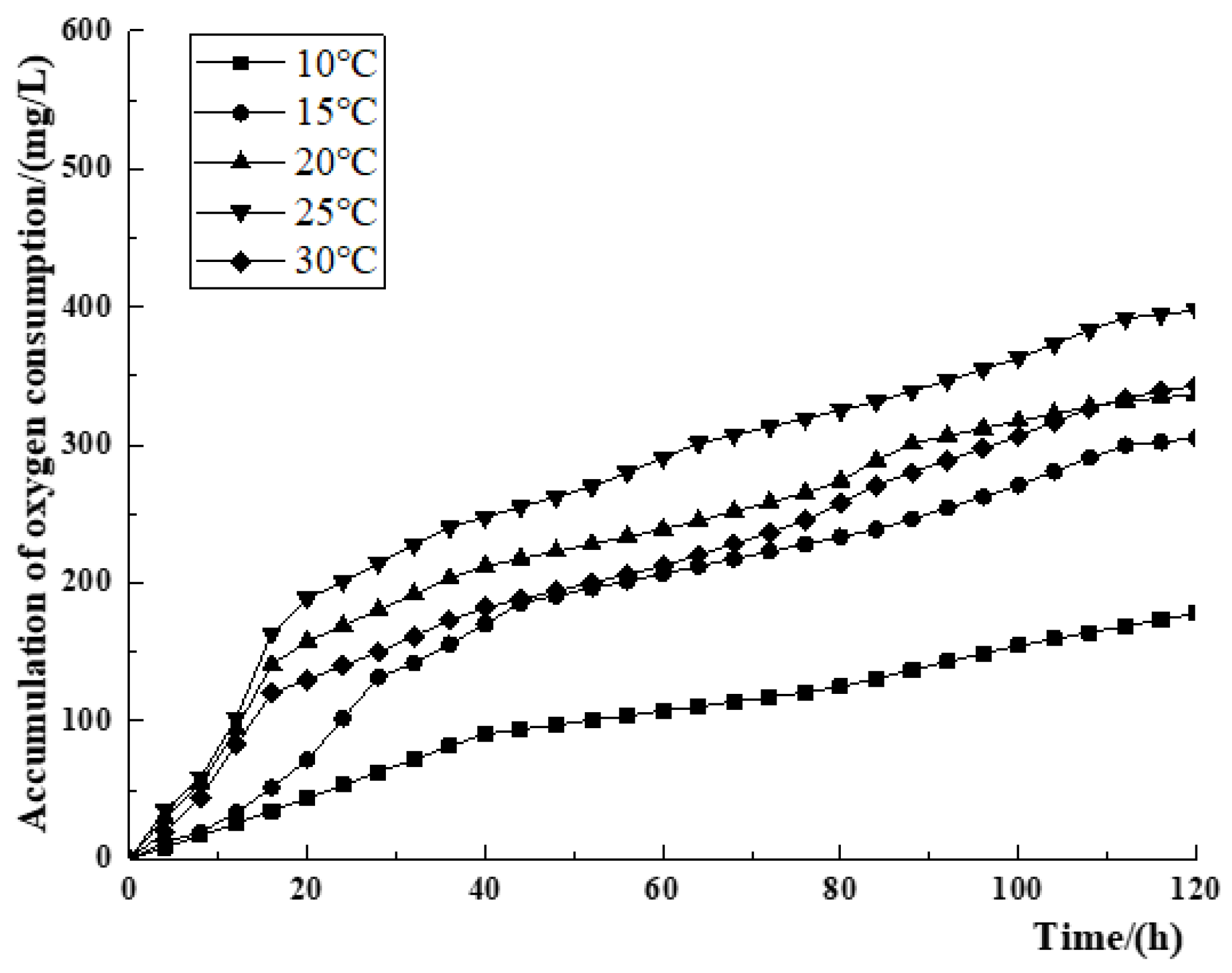
Appendix C.2. Effect of pH on the Biological Treatment Process
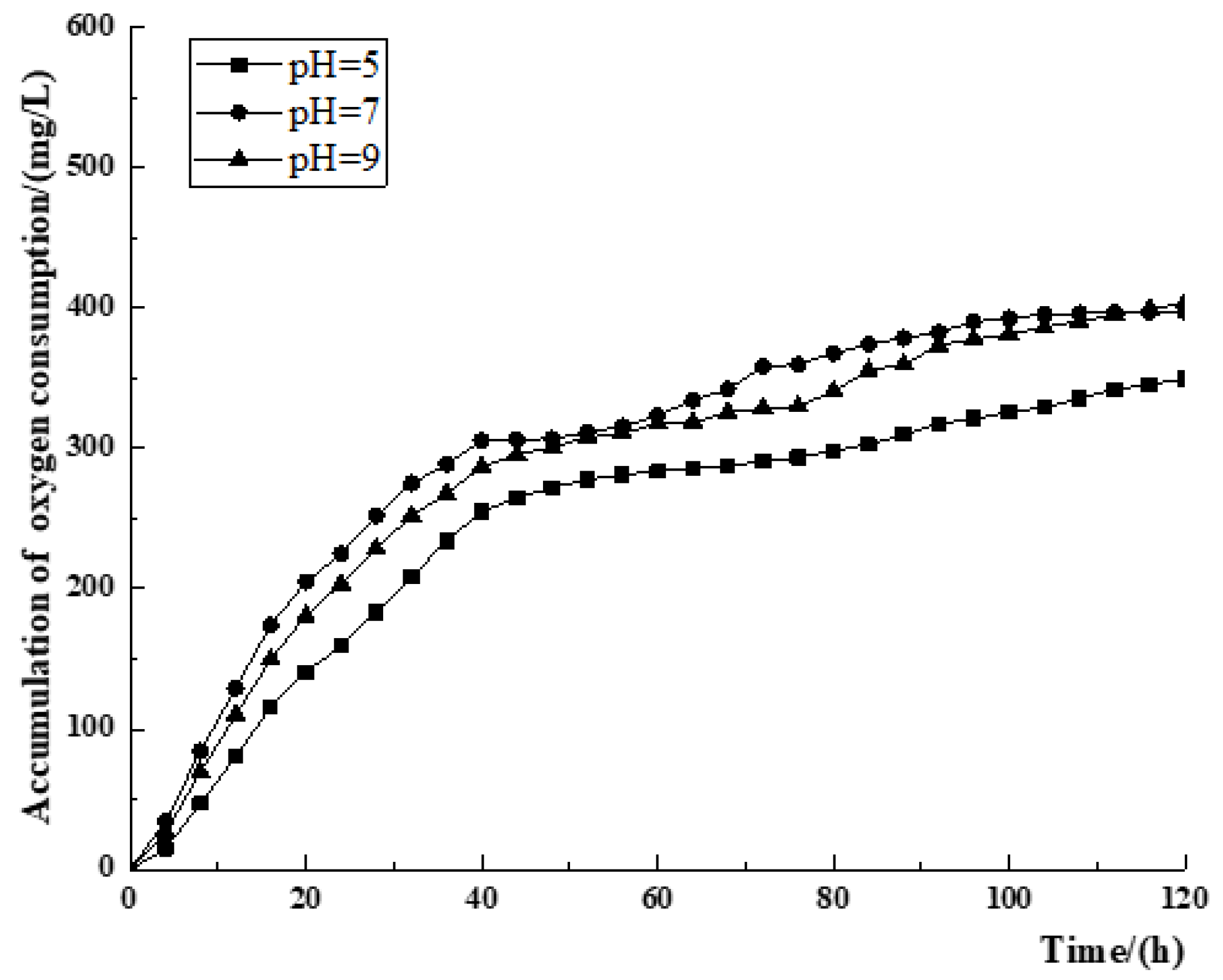
Appendix C.3. Effect of Stirring Rate on the Biological Treatment Process
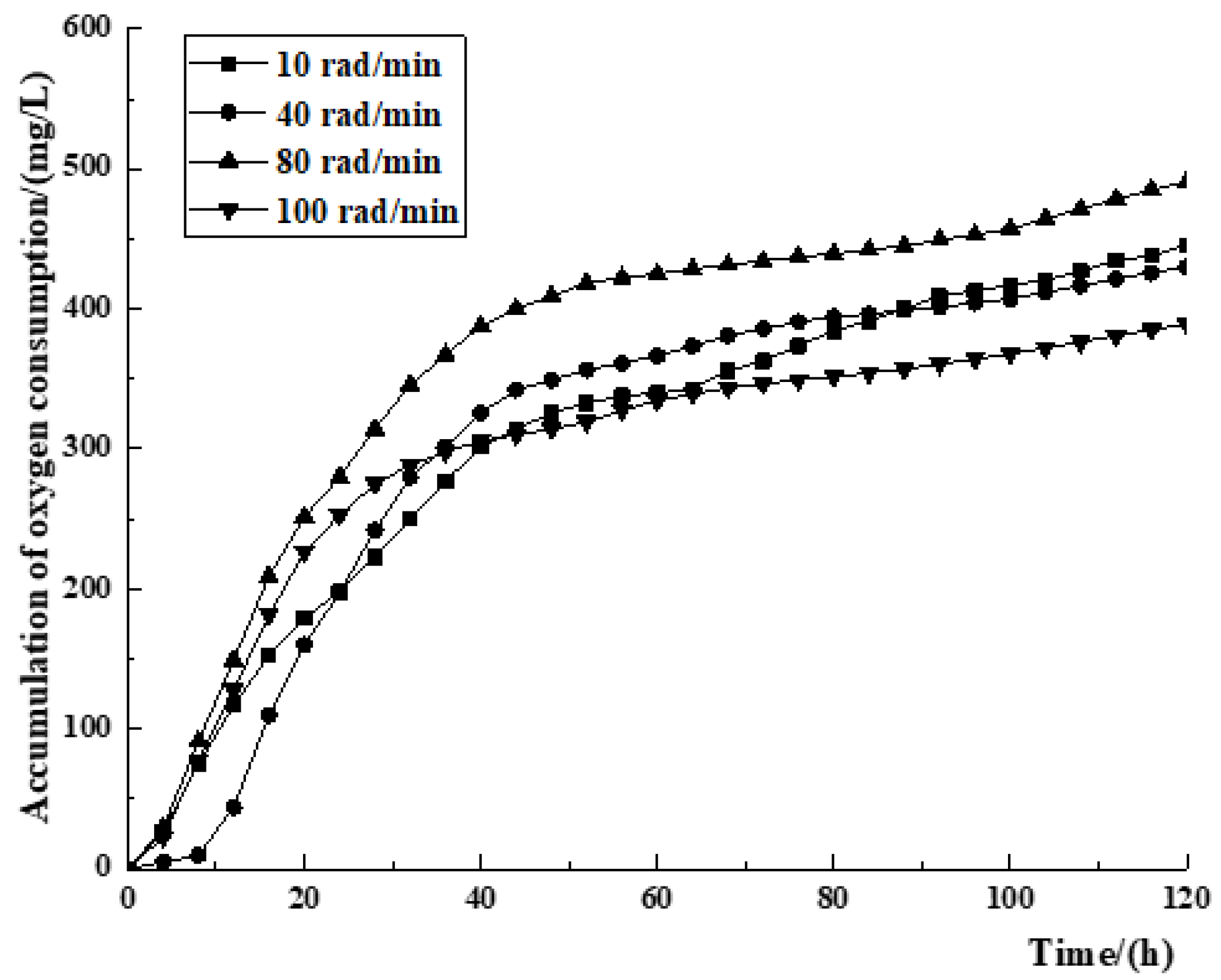
References
- Mozumder, S.I.; Islam, M.A. Development of Treatment Technology for Dye Containing Industrial Wastewater. J. Sci. Res. 2010, 2, 567. [Google Scholar] [CrossRef] [Green Version]
- Jang, J.D.; Barford, J.P.; Renneberg, R. Application of biochemical oxygen demand (BOD) biosensor for optimization of biological carbon and nitrogen removal from synthetic wastewater in a sequencing batch reactor system. Biosens. Bioelectron. 2004, 19, 805–812. [Google Scholar] [CrossRef] [PubMed]
- Baban, A.; Yediler, A.; Ciliz, N.K. Biodegradability oriented treatability studies on high strength segregated wastewater of a woolen textile dyeing plant. Chemosphere 2004, 57, 731–738. [Google Scholar] [CrossRef] [PubMed]
- Hu, H.Y.; Wu, Q.Y.; Wu, G.X. Evaluation of Water Feature and Its Application in the Wastewater Reclamation. Res. Environ. Sci. 2019, 32, 725–733. (In Chinese) [Google Scholar]
- Wang, Y.L.; Li, Y.N.; Tian, L.P. The removal efficiency and mechanism of microplastic enhancement by positive modification dissolved air flotation. Water Environ. Res. 2021, 93, 693–702. [Google Scholar] [CrossRef]
- Helbling, D.E.; Johnson, D.R.; Honti, M. Micropollutant biotransformation kinetics associate with WWTP process parameters and microbial community characteristics. Environ. Sci. Technol. 2012, 46, 10579–10588. [Google Scholar] [CrossRef]
- Hu, H.Y.; Huang, J.J.; Sun, Y. Water Quality Research Methods; Science Press: Beijing, China, 2015; pp. 525–529. [Google Scholar]
- Pardos, M.; Benninghoff, C.; Gueguen, C. Acute toxicity assessment of polish (waste)water with a microplate-based Hydra attenuata assay: A comparison with the Microtox (R) test. Sci. Total Environ. 1999, 243–244, 141–148. [Google Scholar] [CrossRef]
- Kurniawan, S.B.; Abdullah, S.R.S.; Imron, M.F. Challenges and opportunities of biocoagulant/bioflocculant application for drinking water and wastewater treatment and its potential for sludge recovery. Int. J. Environ. Res. Public Health 2020, 17, 9312. [Google Scholar] [CrossRef]
- Bouchaala, L.; Charchar, N.; Sahraoui, H.; Gherib, A. Assessment of wastewater biological treatment efficiency and mapping of WWTPs and LTPs in Algeria. J. Environ. Health Sci. Eng. 2021, 19, 1153–1169. [Google Scholar] [CrossRef]
- Tang, J.C.; Wang, M.; Zheng, X.Q. Analysis on the Characteristics of Waste Water in Chemical Industry Part and its Biological Toxicity. Environ. Monit. China 2012, 28, 20–24. (In Chinese) [Google Scholar]
- Qiu, Y.; Shi, H.C.; Zeng, S.Y. Strategy and Realization of Full-flow Process Control System in Municipal Wastewater Treatment Plants. China Water Wastewater 2011, 27, 16–19. (In Chinese) [Google Scholar]
- Gao, Y.Y.; Yin, F.J.; Ma, W.Q. Rapid detection of biodegradable organic matter in polluted water with microbial fuel cell sensor: Method of partial coulombic yield. Bio Electrochem. 2020, 133, 107488. [Google Scholar] [CrossRef] [PubMed]
- Wang, T.Z.; Hu, H.Y.; Wu, Y.H. Bio-treatment feature and its quantitative evaluation of dyeing wastewater in pipeline. Chin. J. Environ. Eng. 2020, 14, 3021–3029. (In Chinese) [Google Scholar]
- Wang, T.Z.; Wang, W.J.; Hu, H.Y.; Khu, S.T. Effect of coagulation on bio-treatment of textile wastewater: Quantitative evaluation and application. J. Clean. Prod. 2021, 312, 127798. [Google Scholar]
- Ding, K.; Zhou, L.; Zhu, X. Research status of high-concentration refractory organic wastewater treatment technology. Resour. Conserv. Environ. Prot. 2019, 03, 111–112. (In Chinese) [Google Scholar]
- Hu, H.Y.; Koichi, F.; Kohei, U. Characteristic Evaluation and Treatment of Wastewater Containing Noncombustible Working Oil. Saf. Eng. 1994, 33, 2–8. (In Japanese) [Google Scholar]
- Guo, W.C.; Wu, Q.H. Feasibility Analysis of Evaluating Biodegradability of Wastewater using BOD5/CODCr. Environ. Sci. Technol. 1998, 03, 39–41. (In Chinese) [Google Scholar]
- Zhao, X.; Hu, H.Y.; Yu, T. Effect of different molecular weight organic components on the increase of microbial growth potential of secondary effluent by ozonation. J. Environ. Sci. 2014, 26, 2190–2197. [Google Scholar] [CrossRef]
- Lu, X.; Liu, L.; Liu, R. Textile wastewater reuse as an alternative water source for dyeing and finishing processes: A case study. Desalination 2010, 258, 229–232. [Google Scholar] [CrossRef]
- Li, Z.H.; Zhu, Y.M.; Yang, C.J. A simple respirogram-based approach for the management of effluent from an activated sludge system. Bioresour. Technol. 2018, 261, 412–419. [Google Scholar] [CrossRef] [Green Version]
- Guo, Q.J.; Chen, X.P.; Qin, H.L. Analysis and Comparison of Urban Sewage Treatment Processes. China Resour. Compr. Util. 2021, 39, 189–192. (In Chinese) [Google Scholar]
- Shi, G.H.; Liu, Q.S.; Zhang, X.F. Research progress of embedding immobilized microorganism technology in aquaculture water treatment. Technol. Water Treat. 2015, 40, 28–32. [Google Scholar]
- Jiang, S.; Zhang, X. A project example of printing and dyeing wastewater treatment. Ind. Water Wastewater 2020, 51, 62–65. (In Chinese) [Google Scholar]
- Junwon, P.; Naoyuki, Y.; Guangxue, W. Removal of pharmaceuticals and personal care products by ammonia oxidizing bacteria acclimated in a membrane bioreactor: Contributions of cometabolism and endogenous respiration. Sci. Total Environ. 2017, 605–606, 18–25. [Google Scholar]
- Eva, F.P.; Julian, F.N.; Jose, L.A.M. Removal of pharmaceuticals and personal care products by ammonia oxidizing bacteria acclimated in a membrane bioreactor: Contributions of cometabolism and endogenous respiration. J. Clean. Prod. 2019, 232, 858–866. [Google Scholar]
- Wei, Y.; Van Houten, R.T.; Borger, A.R. Minimization of excess sludge production for biological wastewater treatment. Water Res. 2003, 37, 4453–4467. [Google Scholar] [CrossRef]
- Zhang, H.Q. Study of Effect and Mechanism of Coupled Oxidation and Flocculation Process in Treating Dye Wastewater and Micro-polluted Raw Water; Chongqing University: Chongqing, China, 2010. [Google Scholar]
- Ahmed, K.; Emad, S.B.; Khaled, Z. Coagulation/flocculation process for textile mill effluent treatment: Experimental and numerical perspectives. Int. J. Sustain. Eng. 2020, 14, 983–995. [Google Scholar]
- Khan, M.T.; Busch, M.; Molina, V.G. How different is the composition of the fouling layer of wastewater reuse and seawater desalination RO membranes? Water Res. 2014, 59, 271–282. [Google Scholar] [CrossRef]
- Tang, F.; Hu, H.Y.; Sun, L.J. Fouling characteristics of reverse osmosis membranes at different positions of a full-scale plant for municipal wastewater reclamation. Water Res. 2016, 90, 329–336. [Google Scholar] [CrossRef]
- Kayan, I.; Oz, N.A.; Kantar, C. Comparison of treatability of four different chlorophenol-containing wastewater by pyrite-Fenton process combined with aerobic biodegradation: Role of sludge acclimation. J. Environ. Manag. 2020, 279, 111781. [Google Scholar] [CrossRef]
- Chambers, B.; Jones, G.L. Optimization and updating of activated sludge plants by efficient process design. Water Sci. Technol. 1988, 20, 121–132. [Google Scholar] [CrossRef]
- Wu, C.Y. Optimization of Biological Nitrogen and Phosphorus Removal in A2/O Wastewater Treatment Process; Harbin Institute of Technology: Harbin, China, 2010. (In Chinese) [Google Scholar]
- Laís, G.M.S.; Francisca, C.M.; Antonio, A.U. Souza Chemical and electrochemical advanced oxidation processes as a polishing step for textile wastewater treatment: A study regarding the discharge into the environment and the reuse in the textile industry. J. Clean. Prod. 2018, 198, 430–442. [Google Scholar]
- Savin, I.I.; Butnaru, R. Wastewater characteristics in textile finishing mills. Environ. Eng. Manage. J. 2008, 7, 859–864. [Google Scholar] [CrossRef]
- Wu, Y.; Luo, Z.J. A project example of printing and dyeing wastewater treatment by air flotation-hydrolysis acidification-aerobic combined process. Ind. Water Wastewater 2020, 51, 58–60. (In Chinese) [Google Scholar]
- Garcia-ochoa, F.; Gomez, E.; Santos, V.E. Oxygen uptake rate in microbial processes: An overview. Biochem. Eng. J. 2010, 49, 289–307. [Google Scholar] [CrossRef]
- Xiao, G.Y. Design of engineering application in SS and hardness removal for coking plant wastewater treatment. Water Purif. Technol. 2017, 36, 85–89. (In Chinese) [Google Scholar]
- Xue, N.T.; Cao, M.L.; Ji, Y.K. Research statue and development trends of hydrolysis acidification process. Environ. Eng. 2015, 31, 50–54. (In Chinese) [Google Scholar]
- Seredyńska-Sobecka, B.; Tomaszewska, M.; Janus, M.; Morawski, A.W. Biological activation of carbon filters. Water Res. 2006, 40, 355–363. [Google Scholar] [CrossRef]
- Ikumi, D.S.; Harding, T.H.; Ekama, G.A. Biodegradability of wastewater and activated sludge organics in anaerobic digestion. Water Res. 2014, 56, 267–279. [Google Scholar] [CrossRef] [Green Version]
- Phillips, R.B.; James, R.R.; Magnuson, M.L. Functional categories of microbial toxicity resulting from three advanced oxidation process treatments during management and disposal of contaminated water. Chemosphere 2020, 238, 124550.1–124550.8. [Google Scholar] [CrossRef]
- Li, Y.Y. Preparation of Fiber-Based Adsorpent and Catalytic Material and Its Application in Decolorization of Printing and Dyeing Wastewater; Xi’an Polytechnic University: Xi’an, China, 2021. [Google Scholar] [CrossRef]
- Wang, X.Y.; Gao, J. Absorption spectra of gelatin copper complexes and copper (II) sulfate and their impact on cotton peroxide bleaching. J. Nat. Fibers 2019, 16, 307–318. [Google Scholar] [CrossRef]
- Figueiredo, G.G.O.; Lopes, V.R.; Romano, T. Clostridium, Beneficial Microbes in Agro-Ecology; Academic Press: Cambridge, MA, USA, 2020; Chapter 22; pp. 477–491. [Google Scholar]
- Yu, C.; Wang, K.J.; Tian, C. Aerobic granular sludge treating low-strength municipal wastewater: Efficient carbon, nitrogen and phosphorus removal with hydrolysis-acidification pretreatment. Sci. Total Environ. 2021, 792, 148297. [Google Scholar] [CrossRef] [PubMed]
- Qiu, Z.F.; Wang, X.; Lu, S.G. Comparison between A2/O and ALO processes for treatment of municipal wastewater with low C/N ratio (in Chinese). China Water Wastewater 2012, 28, 12–16. [Google Scholar]
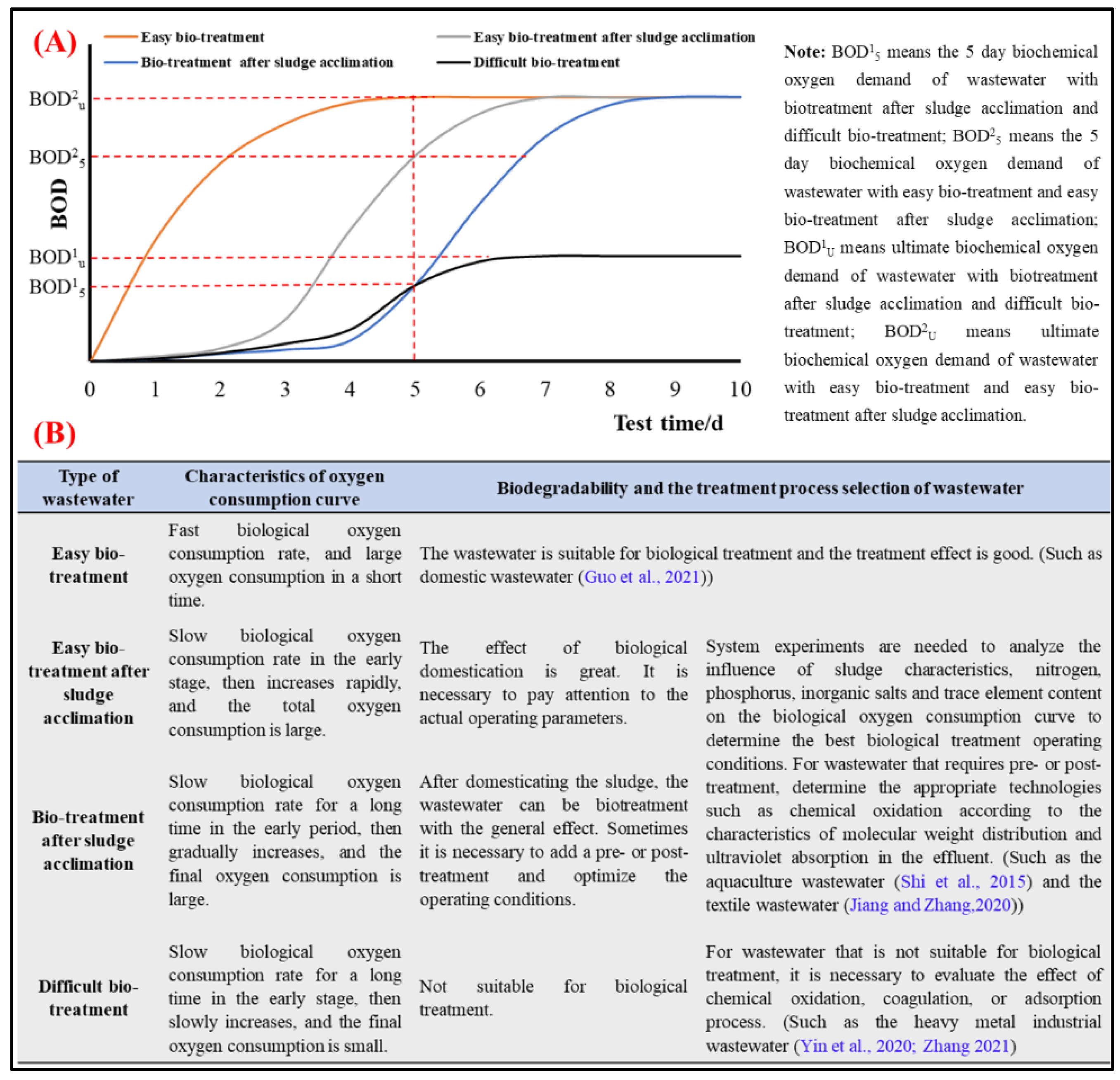
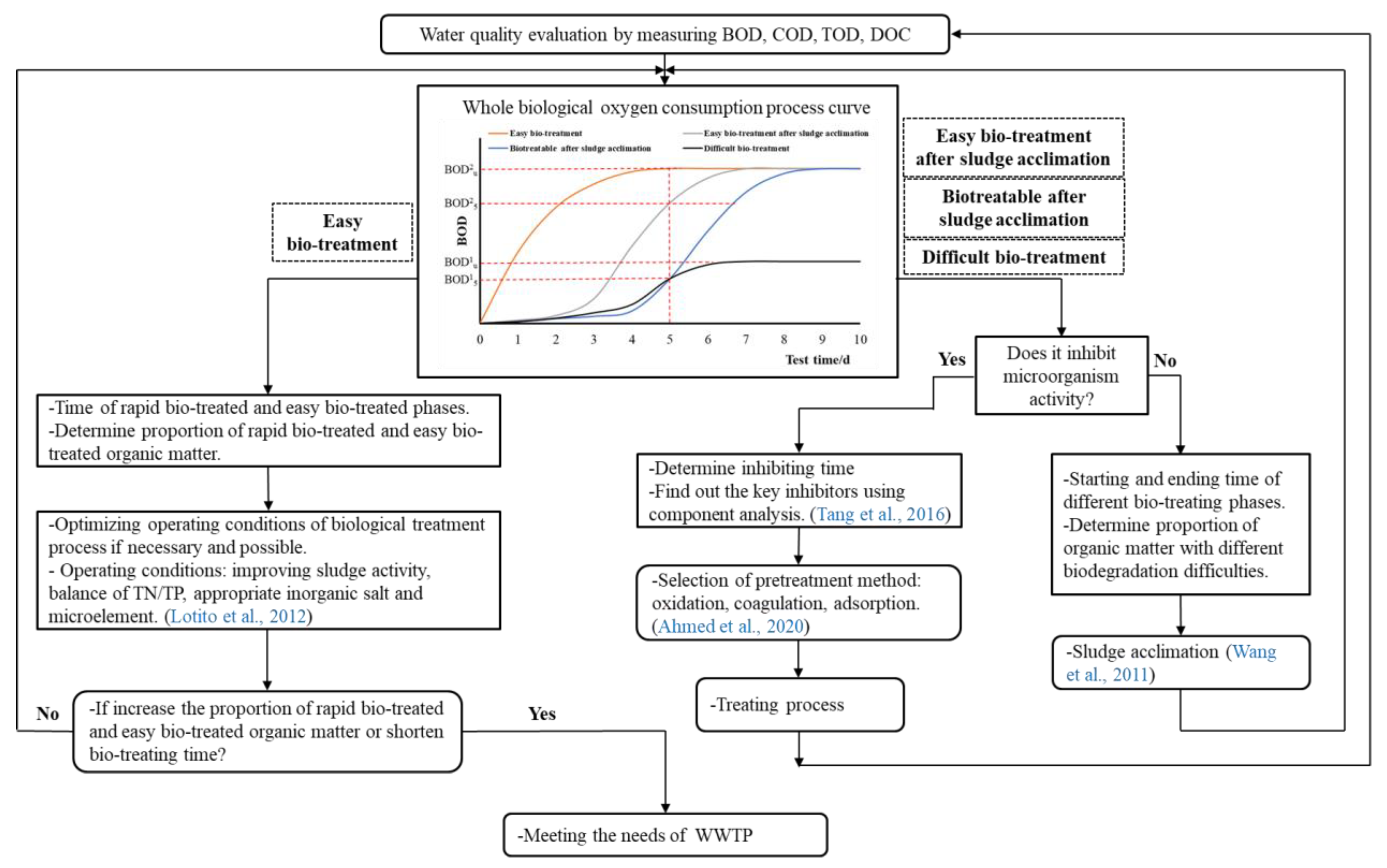

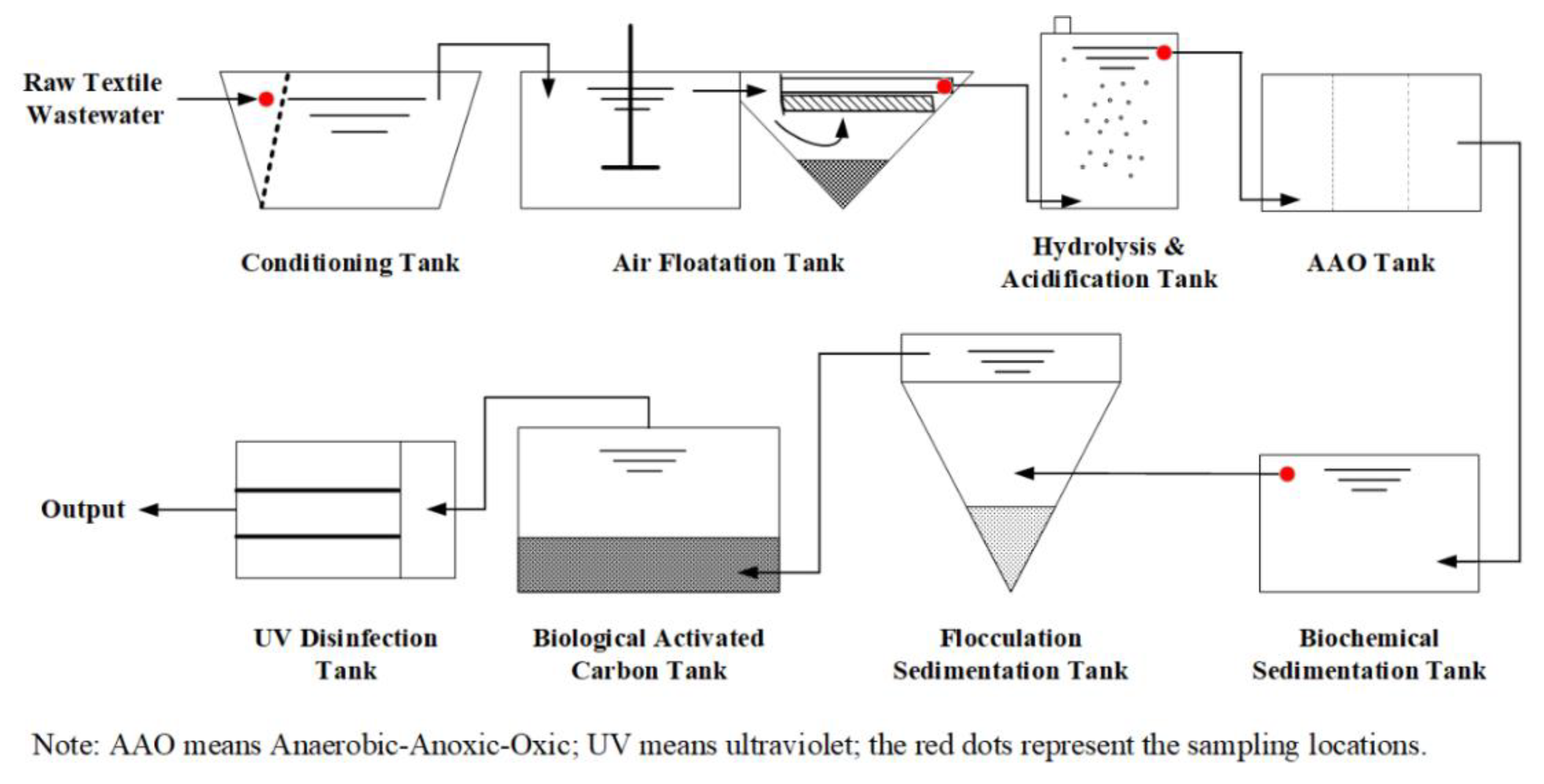
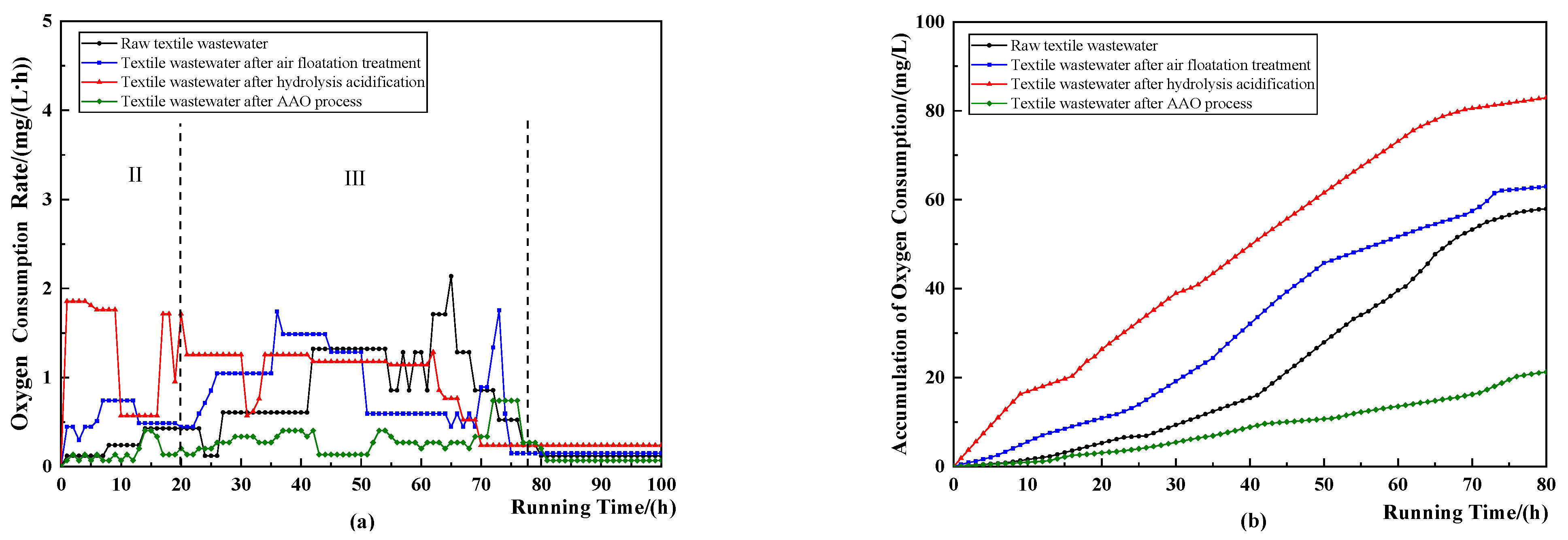
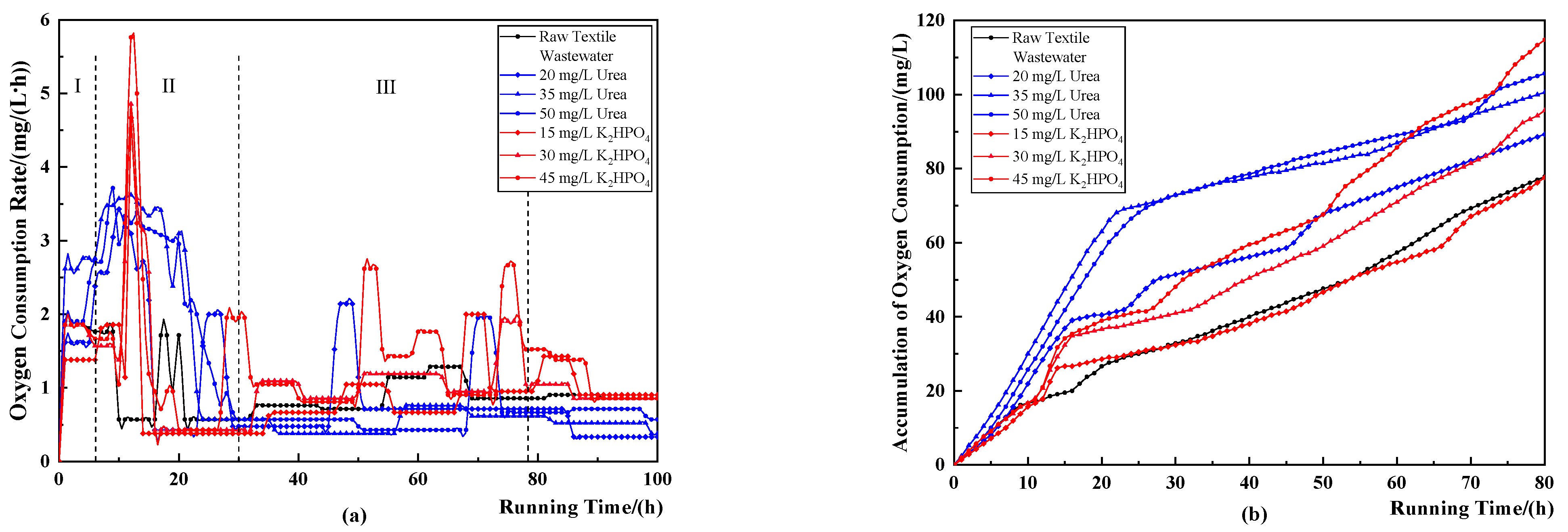
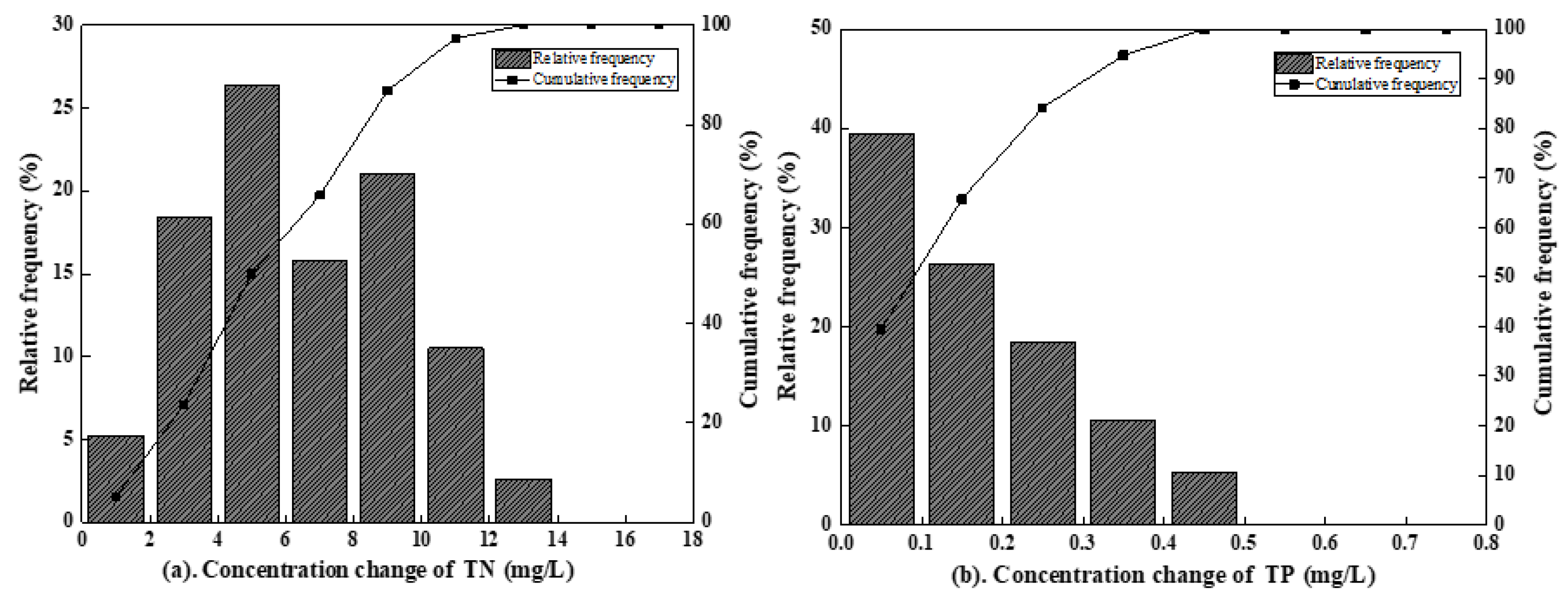
| Indicators | Values | Biodegradability | Citations |
|---|---|---|---|
| BOD5/COD | 0.4~0.6 | Easily biodegradable | [18] |
| BOD5/DOC | >1.2 | Easily biodegradable | [17] |
| BOD5/COD | 0.2~0.4 | Difficult to be biodegradable | [7] |
| BOD5/COD | <0.1 | Non-biodegradable | [14] |
| Water Quality | COD (mg/L) | BOD5 (mg/L) | SS (mg/L) | TN (mg/L) | TP (mg/L) | B/C | C:N:P |
|---|---|---|---|---|---|---|---|
| Raw textile wastewater | 323 | 64 | 215 | 12.8 | 0.33 | 0.20 | 979:39:1 |
| Textile wastewater after air floatation | 300 | 61 | 79 | 11.6 | 0.31 | 0.20 | 968:37:1 |
| Textile wastewater after hydrolysis acidification | 244 | 78 | 63 | 10.5 | 0.25 | 0.32 | 976:45:1 |
| Textile wastewater after AAO process | 153 | 15 | 32 | 3.5 | 0.17 | 0.10 | 423:21:1 |
| Type of Organic Pollutions | Rapid Bio-Treated | Easy Bio-Treated | Normal Bio-Treated | Non-Biological Treatment |
|---|---|---|---|---|
| Raw textile wastewater | 0 | 5 | 52 | 266 |
| Textile wastewater after air floatation treatment | 2 | 7 | 53 | 238 |
| Textile wastewater after hydrolysis acidification | 5 | 24 | 51 | 164 |
| Textile wastewater after AAO process | 0 | 3 | 17 | 133 |
| Nutrient Sources | Dosing Concentration (mg/L) | Concentration after Input into Textile Wastewater (mg/L) | |
|---|---|---|---|
| TN | TP | ||
| Urea | 20 | 16.54 | — a |
| 35 | 23.88 | — a | |
| 50 | 30.35 | — a | |
| K2HPO4 | 15 | — a | 2.72 |
| 30 | — a | 6.04 | |
| 45 | — a | 7.89 | |
| Type of Organic Pollutions | Rapid Bio-Treated (mg/L) | Easy Bio-Treated (mg/L) | Normal Bio-Treated (mg/L) | Non-Biological Treatment (mg/L) | |
|---|---|---|---|---|---|
| KB a | 0 | 16 | 42 | 262 | |
| Supplement dosage of nitrogen (Urea) | 15 | 0 | 39 | 36 | 245 |
| 30 | 13 | 57 | 17 | 233 | |
| 45 | 10 | 63 | 16 | 231 | |
| Supplement dosage of phosphorus (K2HPO4) | 14 | 0 | 26 | 25 | 269 |
| 28 | 0 | 35 | 42 | 243 | |
| 42 | 0 | 39 | 54 | 227 | |
Publisher’s Note: MDPI stays neutral with regard to jurisdictional claims in published maps and institutional affiliations. |
© 2022 by the authors. Licensee MDPI, Basel, Switzerland. This article is an open access article distributed under the terms and conditions of the Creative Commons Attribution (CC BY) license (https://creativecommons.org/licenses/by/4.0/).
Share and Cite
Wang, T.; Wang, W.; Hu, H.; Khu, S.-T. Novel Quantitative Evaluation of Biotreatment Suitability of Wastewater. Water 2022, 14, 1038. https://doi.org/10.3390/w14071038
Wang T, Wang W, Hu H, Khu S-T. Novel Quantitative Evaluation of Biotreatment Suitability of Wastewater. Water. 2022; 14(7):1038. https://doi.org/10.3390/w14071038
Chicago/Turabian StyleWang, Tianzhi, Weijie Wang, Hongying Hu, and Soon-Thiam Khu. 2022. "Novel Quantitative Evaluation of Biotreatment Suitability of Wastewater" Water 14, no. 7: 1038. https://doi.org/10.3390/w14071038
APA StyleWang, T., Wang, W., Hu, H., & Khu, S.-T. (2022). Novel Quantitative Evaluation of Biotreatment Suitability of Wastewater. Water, 14(7), 1038. https://doi.org/10.3390/w14071038







